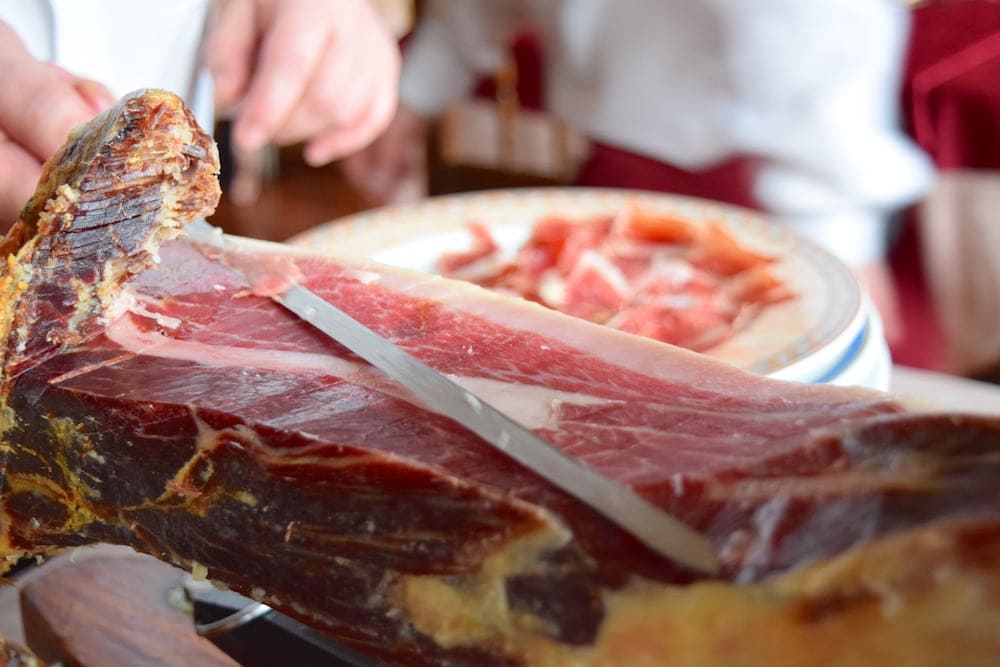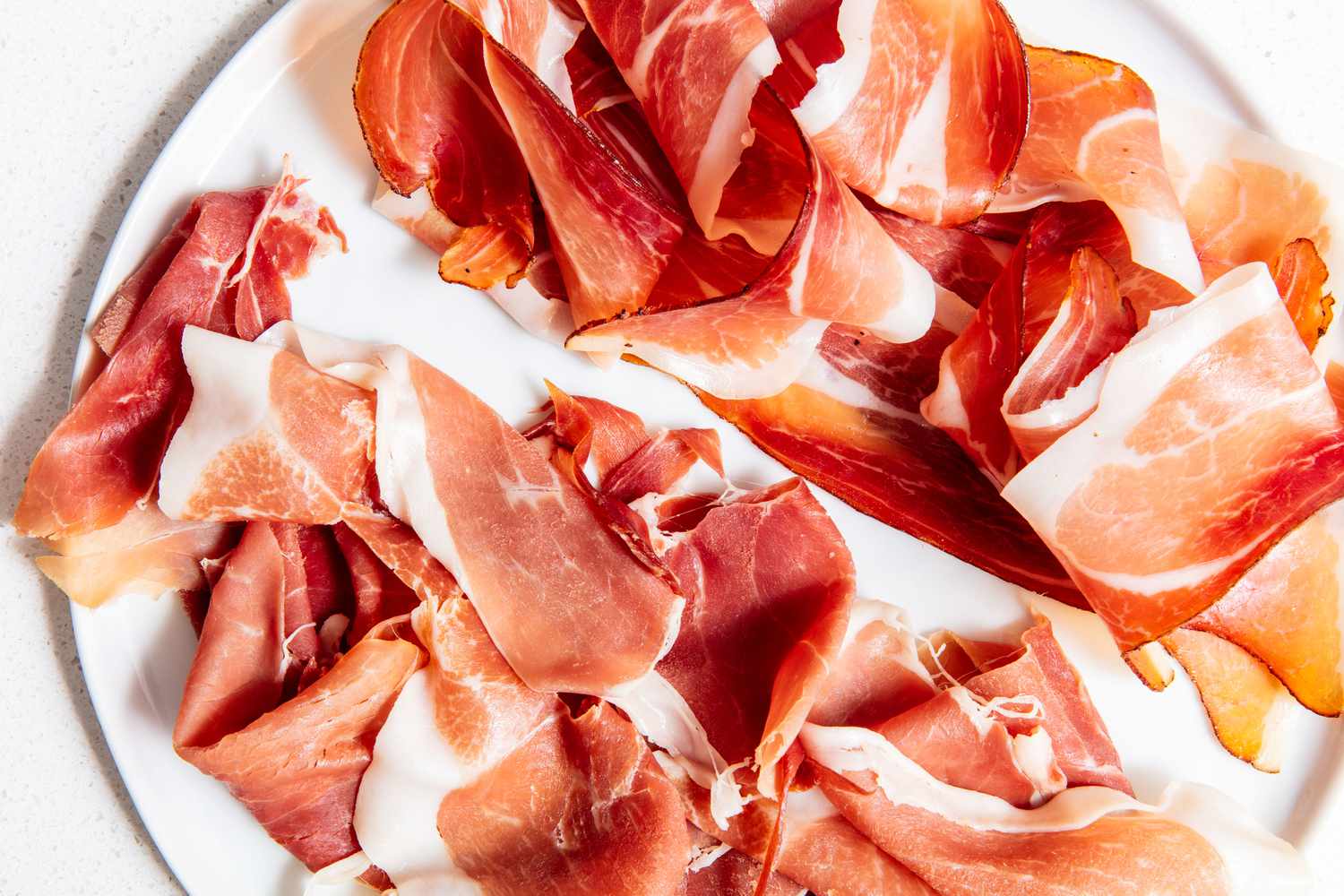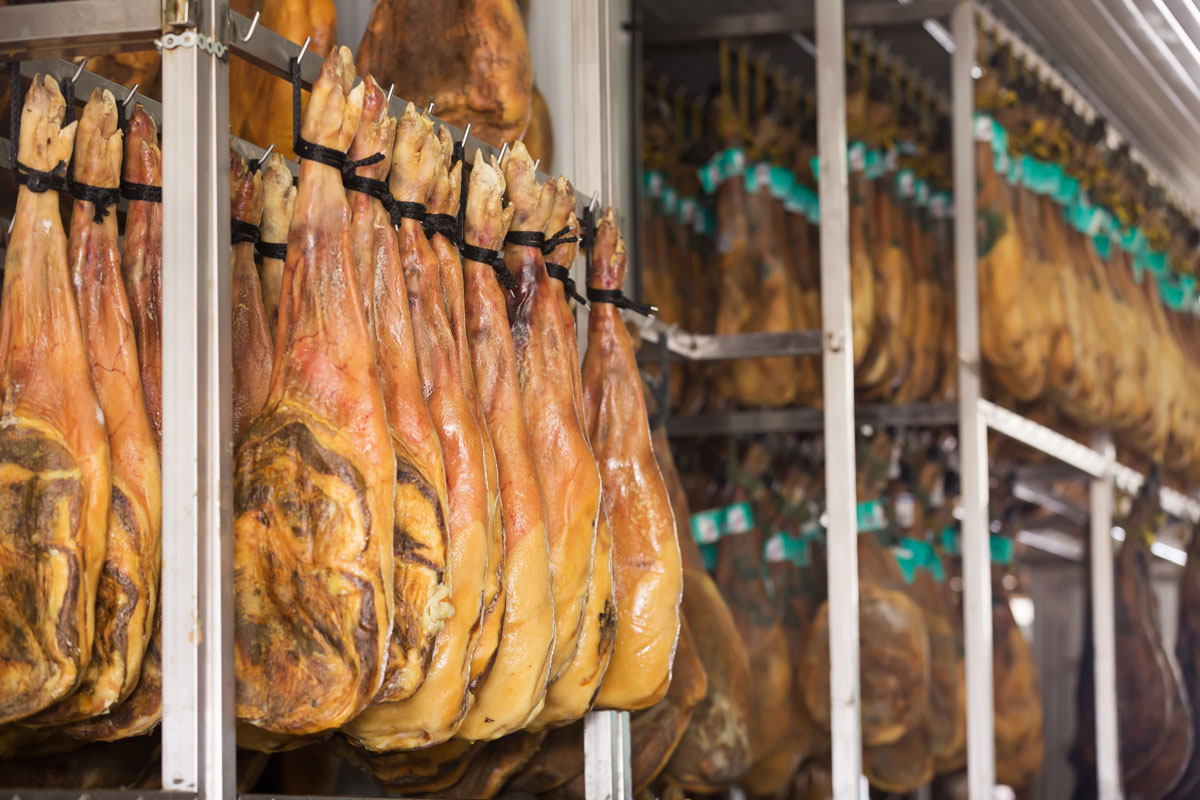Introduction

The world of Spanish cured meats is rich and diverse, with two popular options taking center stage: Serrano and Iberico. These meats have a long-standing history in Spanish cuisine and are beloved for their unique flavors and characteristics. Serrano, made from a common breed of white pig, and Iberico, made from the rare and special black Iberian pig, offer distinct taste profiles that captivate the senses. In this article, we will delve into the differences between Serrano and Iberico meats, exploring their flavor profiles, processing methods, and culinary uses. Join us on this meaty showdown as we compare and contrast Serrano vs Iberico!
History And Significance Of Serrano And Iberico Meats In Spanish Cuisine
Serrano and Iberico meats have a rich history and hold great significance in Spanish cuisine. Serrano, derived from a common breed of white pig, has been consumed in Spain for centuries, making it a staple in the country’s culinary traditions. On the other hand, Iberico ham, made from the rare and unique black Iberian pig, is highly prized and represents a luxury delicacy. These meats have become emblematic of Spanish culture and are often featured in traditional dishes, tapas, and charcuterie boards. Their distinct flavors and textures add depth and authenticity to Spanish cuisine, making them cherished and sought after by food enthusiasts around the world .
Traditional Methods Of Curing And Preparing These Meats
Traditional methods of curing and preparing Serrano and Iberico meats are deeply rooted in Spanish culinary traditions. Both hams undergo a meticulous process that involves salting, air drying, and aging over a specific period of time. The meat is first salted and left to rest for several weeks, allowing the salt to penetrate and preserve the meat. Afterward, the hams are hung in a cool, dry environment for months or even years. This slow and careful curing process results in the development of the unique flavors and textures that are characteristic of Serrano and Iberico meats.
Serrano Ham

Serrano ham is a traditional Spanish cured ham that is renowned for its delicious flavor and unique characteristics. It is made from the meat of white pigs and undergoes a meticulous curing process that results in a tender and flavorful ham. Serrano ham has a rich, savory taste with a slightly salty undertone. It is often described as having a balanced flavor profile with hints of nuttiness and a pleasant aroma. The texture of Serrano ham is firm yet delicate, making it perfect for slicing thinly and enjoying as a standalone delicacy or in various culinary dishes.
Serrano Ham: Flavor Profile And Characteristics
Serrano ham is renowned for its delicious flavor and unique characteristics. It has a rich, savory taste with a slightly salty undertone. The flavor of Serrano ham is well-balanced, with hints of nuttiness and a pleasant aroma. Its texture is firm yet delicate, making it perfect for slicing thinly. The curing process enhances the flavors and results in a tender, melt-in-your-mouth texture. Serrano ham is a versatile ingredient that can be enjoyed on its own or incorporated into various culinary dishes, adding depth and richness to any recipe.
Different Types Of Serrano Hams And Their Aging Process
There are different types of Serrano hams, each with its own unique aging process. The most common types include “Serrano Reserva” and “Serrano Gran Reserva.” The Reserva ham is aged for a minimum of 9 months, resulting in a milder flavor and a softer texture. On the other hand, Gran Reserva ham is aged for a minimum of 12 months, allowing it to develop a deeper, more intense flavor and a firmer texture. The aging process is crucial in enhancing the flavors and achieving the desired characteristics of each type of Serrano ham.
Iberico Ham

Iberico Ham, also known as Jamón Ibérico, is a prized delicacy in Spanish cuisine. It is made from the meat of the Iberian pig, a rare and special breed that is native to the Iberian Peninsula. The unique diet of these pigs, which includes acorns, gives the ham its distinct flavor and marbling. Iberico ham is known for its rich, nutty taste and melt-in-your-mouth texture. The meat is cured for a minimum of 36 months, allowing it to develop its complex flavors and tender texture. It is considered a true gourmet experience and is often enjoyed on its own or as a luxurious ingredient in various dishes.
Iberico Ham: Flavor Profile And Characteristics
Iberico Ham has a distinct flavor profile and unique characteristics that set it apart from other types of ham. The flavor can be described as rich, nutty, and slightly sweet, with a hint of saltiness. The marbling of fat within the meat gives it a luxurious, melt-in-your-mouth texture. The Iberian pigs are known for their exceptional taste, thanks to their diet of acorns and natural herbs. This results in a ham that is deeply flavorful and aromatic. The fat content in Iberico ham adds an extra layer of richness and juiciness, making it a true culinary delight.
The Unique Qualities Of Iberico Pigs And Their Impact On The Taste
Iberico pigs have unique qualities that contribute to the exceptional taste of Iberico ham. These pigs are indigenous to the Iberian Peninsula and are known for their ability to accumulate a high amount of intramuscular fat, also known as marbling. This fat content not only adds richness and juiciness to the meat but also enhances the flavor profile. Additionally, the diet of Iberian pigs plays a crucial role in the taste of the ham. These pigs graze on acorns and natural herbs, resulting in a distinct nutty and slightly sweet flavor. The combination of the pig’s genetic predisposition and their diet gives Iberico ham its highly sought-after and unique taste.
Serrano Vs Iberico: Taste And Texture Comparison

When it comes to comparing the taste and texture of Serrano and Iberico meats, there are noticeable differences. Serrano ham has a slightly milder flavor compared to Iberico ham. Its texture is firm and slightly dry, but still tender. On the other hand, Iberico ham boasts a more intense flavor and a succulent texture. The high amount of intramuscular fat in Iberico ham adds richness and juiciness, making it more luxurious and satisfying on the palate. The marbling of the fat in Iberico ham also contributes to its tenderness and melt-in-your-mouth quality. Additionally, the fat in Iberico ham stimulates the taste buds, resulting in a more flavorful experience. In terms of texture, Iberico ham is silkier and more moist, whereas Serrano ham has a firmer texture.
A Comparison Of Flavor, Tenderness, And Marbling Between Serrano And Iberico Meats
When comparing the flavor, tenderness, and marbling of Serrano and Iberico meats, there are noticeable differences. Serrano ham has a slightly milder flavor compared to Iberico ham, which has a more intense and luxurious taste. In terms of tenderness, Iberico ham takes the crown with its succulent and melt-in-your-mouth texture, thanks to its high intramuscular fat content. Serrano ham, while still tender, has a firmer texture. When it comes to marbling, Iberico ham’s fat is distributed throughout the meat, resulting in a more flavorful and moist eating experience.
The Influence Of Diet And Exercise On The Meat Quality
Diet and exercise play a crucial role in determining the quality of both Serrano and Iberico meats. The breed of pigs used in the production of Iberico ham is known for their free-range and acorn-fed diet, which contributes to the unique flavor and marbling of the meat. The exercise they get while foraging for acorns helps distribute fat throughout the muscle fibers, resulting in a tender and flavorful product. On the other hand, Serrano ham is typically made from pigs that are raised on a controlled diet, which may not have the same impact on the meat quality.
Culinary Uses And Pairings

Serrano and Iberico hams are incredibly versatile when it comes to culinary uses. Serrano ham is perfect for adding a savory and delicate flavor to a variety of dishes. It can be used in sandwiches, salads, pastas, omelets, and even pizzas. On the other hand, Iberico ham has a rich and intense flavor that pairs well with bold and complex flavors. It can be enjoyed on its own as a charcuterie board, or incorporated into gourmet recipes such as risottos, stews, and tapas. When it comes to pairings, both meats complement well with various ingredients and styles. Serrano ham can be paired with fresh fruits, mild cheeses, and crusty bread, while Iberico ham can be paired with aged cheeses, olives, and full-bodied red wines. Whichever ham you choose, it is sure to elevate your dishes and impress your guests.
Creative Ways To Incorporate Serrano And Iberico Meats In Recipes
There are countless creative ways to incorporate both Serrano and Iberico meats into your recipes. For Serrano ham, you can add thin slices to a refreshing summer salad for an extra burst of flavor, or wrap it around asparagus before grilling for a delicious appetizer. Iberico ham, with its rich and intense flavor, is perfect for elevating dishes like pasta carbonara or homemade pizzas. It can also be used as a topping for crostini or mixed into creamy risottos for a decadent twist. The possibilities are endless when it comes to incorporating these Spanish meats into your culinary creations.
Recommended Wine And Cheese Pairings For Both Meats
When it comes to pairing wines with Serrano and Iberico meats, there are a few options that complement their flavors perfectly. For Serrano ham, a dry and crisp white wine such as a Sauvignon Blanc or a sparkling Cava would be an excellent choice. These wines help to cut through the richness of the ham and enhance its savory notes. As for Iberico ham, a bold and full-bodied red wine like a Rioja or a Tempranillo would be a great match. The complex flavors of the Iberico ham are beautifully complemented by the depth and richness of these red wines. When it comes to cheese pairings, Serrano ham pairs wonderfully with Manchego or a mild goat cheese, while Iberico ham pairs well with aged cheeses like Parmigiano-Reggiano or Pecorino Romano. These combinations create a delightful balance of flavors, making each bite a true culinary pleasure.
Conclusion

In conclusion, the showdown between Serrano and Iberico meats reveals the rich and diverse culinary traditions of Spanish cuisine. Both meats have their unique flavor profiles and characteristics that are influenced by factors such as the breed of pig and their diet.
While Serrano ham offers a delicious and accessible option with its savory notes and tender texture, Iberico ham stands out with its unparalleled richness and complexity.
Whether you prefer the traditional flavors of Serrano or indulge in the luxurious experience of Iberico, both meats are sure to satisfy any meat lover’s palate. The choice between the two ultimately comes down to personal preference and the occasion. So, why not embark on a culinary journey and explore the unique flavors of both Serrano and Iberico meats?
Final Verdict On The Serrano Vs Iberico Meat Showdown
After comparing the flavors, textures, and characteristics of Serrano and Iberico meats, the final verdict on the showdown is that both types have their own unique appeal. Serrano ham offers a delicious and accessible option with its savory notes and tender texture. On the other hand, Iberico ham stands out with its unparalleled richness and complexity, making it a truly luxurious choice. Ultimately, the choice between Serrano and Iberico comes down to personal preference. So, why not indulge in both and experience the rich flavors of Spanish cuisine?
Considerations For Choosing Between Serrano And Iberico Meats
When deciding between Serrano and Iberico meats, there are a few considerations to keep in mind. First, consider your budget, as Iberico ham is typically more expensive due to its premium qualities. If you’re looking for a more affordable option, Serrano ham is a great choice. Another factor to consider is the level of richness and complexity you prefer in your meat. If you enjoy a more intense and luxurious flavor, Iberico ham is the way to go. However, if you prefer a milder and more accessible flavor, Serrano ham is a delicious option. Ultimately, it comes down to personal preference and the level of indulgence you desire. So go ahead, explore both options and savor the delights of Spanish cuisine.
Serrano vs. Ibérico: Frequently Asked Questions
Q: What is the difference between Serrano and Ibérico?
A: Serrano and Ibérico are both types of cured Spanish ham, but they come from different breeds of pigs and vary in terms of flavor, texture, and quality.
Q: What breed of pig is used for Serrano ham?
A: Serrano ham comes from the white pig breed known as Landrace or Large White. These pigs are raised in various regions of Spain.
Q: What breed of pig is used for Ibérico ham?
A: Ibérico ham comes from black Iberian pigs, which are native to the Iberian Peninsula in Spain and Portugal. These pigs are known for their ability to accumulate fat within the muscle, enhancing the flavor.
Q: How do the pigs’ diets differ between Serrano and Ibérico?
A: Serrano pigs primarily feed on a combination of grains, cereals, and legumes. In contrast, Ibérico pigs enjoy a unique diet of acorns (known as “bellota”) during the fattening period, which contributes to the distinctive taste and marbling in the meat.
Q: What is the aging process for Serrano and Ibérico hams?
A: Serrano hams are aged for around 9 to 12 months, while Ibérico hams have a longer aging period that can range from 12 to 48 months. This extended aging allows the flavors to intensify and the meat to become more tender.
Q: How does the flavor of Serrano ham compare to Ibérico ham?
A: Serrano ham has a milder taste, slightly salty, with a firm texture. In contrast, Ibérico ham offers a richer and more complex flavor profile. The meat is marbled with flavorful fat, providing a nutty, buttery taste that melts in your mouth.
Q: Which ham is considered to be of higher quality, Serrano or Ibérico?
A: Ibérico ham is generally regarded as a higher quality product due to several factors such as the exclusivity of the breed, the acorn-fed diet, and the longer aging process. However, Serrano ham is still highly regarded and enjoyed worldwide for its delicious taste and affordability.
Q: Are Serrano and Ibérico hams widely available outside of Spain?
A: While Serrano ham is more commonly found worldwide and can be easily sourced, Ibérico ham may be less widely available and is often considered more of a specialty product. However, both types can be purchased online through specialized retailers.
Q: How should I store Serrano and Ibérico hams?
A: It is recommended to store both types of ham in a cool, dry place with good ventilation. Serrano ham can be stored for up to a year, while Ibérico ham has a longer shelf life of 1 to 2 years when properly stored.
In summary, Serrano and Ibérico hams differ in terms of pig breed, diet, aging process, and flavor. While Ibérico ham is considered of higher quality, Serrano ham remains a delicious and more affordable alternative. The choice between the two ultimately depends on personal preference and budget.

From At-Home Dinner Parties to Family Reunions to Office Parties, we can cater your next Event!